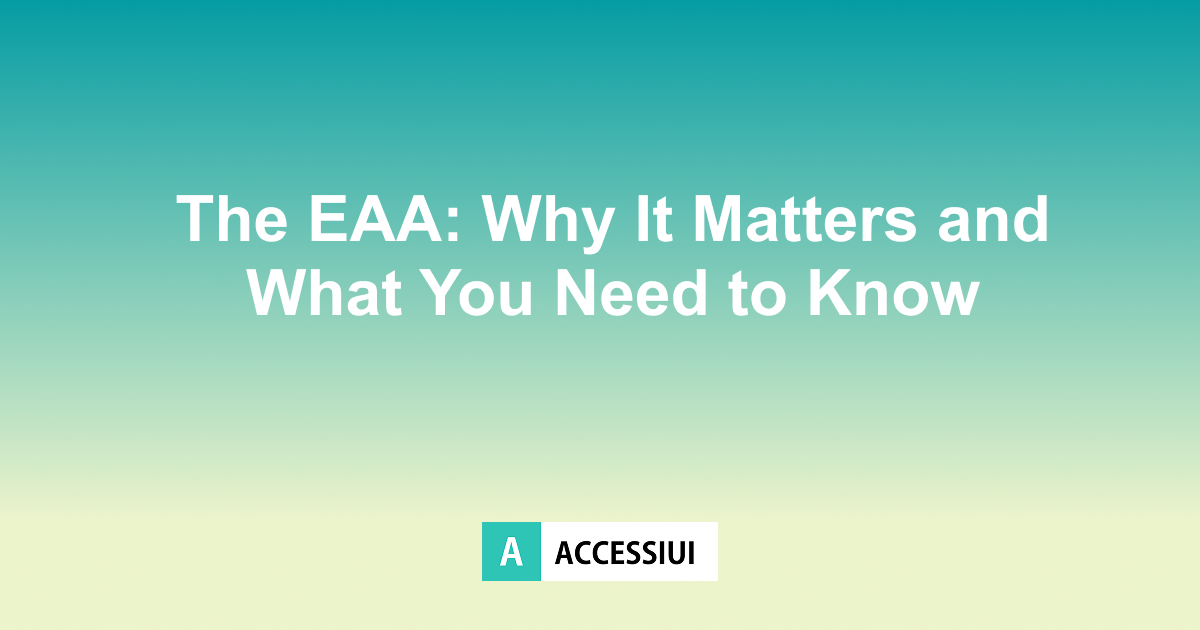The European Accessibility Act: Why It Matters and What You Need to Know
Transfon

Imagine trying to buy a train ticket online but the website doesn’t work with your screen reader. Or using a banking app that’s impossible to navigate without a mouse. For millions of people across Europe, these aren’t hypotheticals. They’re daily barriers. The European Accessibility Act (EAA) aims to change that. Here’s what it is, why it matters, and what your business needs to do about it.
What is the European Accessibility Act?
The European Accessibility Act (Directive (EU) 2019/882) is an EU-wide law that sets accessibility requirements for key products and services to make life easier for people with disabilities and older people.
Key timeline:
-
2019 – Adopted by the EU.
-
June 2022 – Member States transpose it into national law.
-
28 June 2025 – Full compliance deadline for businesses.
Put simply: if you sell certain products or provide services in the EU, they need to be accessible by mid-2025.
Who does it apply to?
The EAA applies to manufacturers, importers, distributors, and service providers offering:
Products like:
-
Computers and operating systems
-
Smartphones and e-readers
-
ATMs, ticketing machines, check-in kiosks
-
Televisions and related equipment
Services like:
-
E-commerce websites and apps
-
Banking services
-
Electronic communications (e.g. messaging, calls)
-
Transport ticketing and real-time travel information
-
Audiovisual media services (TV, streaming platforms)
If your business operates in these areas within the EU, EAA compliance is not optional. Microenterprises (fewer than 10 employees and turnover under €2 million) may be exempt in some cases, but it remains best practice to implement accessibility wherever possible.
What are the core requirements?
At its heart, the EAA requires that products and services are:
-
Perceivable: Content must be presented in ways users can perceive, like text alternatives for images.
-
Operable: Interfaces must be usable with various assistive technologies (keyboard navigation, voice input).
-
Understandable: Content and operation must be clear and intuitive.
-
Robust: Compatible with current and future technologies.
These principles align closely with the Web Content Accessibility Guidelines (WCAG) and EN 301 549 standards.
Why does this matter for your business?
-
Avoid legal risks. Non-compliance can lead to fines, removal from market, or reputational damage.
-
Expand your market. Over 100 million people in the EU have a disability – accessibility isn’t just about compliance; it’s about inclusion and business growth.
-
Strengthen your brand. Accessibility demonstrates a commitment to social responsibility, enhancing your reputation with customers, employees, and partners alike.
What should you do next?
Here’s a practical roadmap:
-
Assess: Identify which of your products and services fall under the EAA.
-
Evaluate: Review your current accessibility levels against WCAG and EN 301 549 standards.
-
Plan: Create a detailed compliance strategy that covers design changes, development, procurement, and user testing.
-
Train: Upskill your teams to embed accessibility into design and development processes.
-
Publish: Prepare accessibility statements where required to demonstrate compliance.
-
Monitor: Build processes to keep your products and services accessible over time.
Moving Forward with Accessibility
The European Accessibility Act is more than a regulation. It’s a call to create products and services that work for everyone. It’s also a reminder that good design is inclusive design, and inclusive design drives better business outcomes. AccessiUI simplify the process by enhancing digital accessibility efficiently. Whether you’re remediating existing platforms or designing new ones, AccessiUI helps ensure your interfaces are usable for everyone.

